Assessment of Sinkhole Hazard in the Area of Shallow Mining Workings Using Electrical Resistivity Tomography
Abstract
:1. Introduction
- Anthropogenic factors related to human activity, mainly concerning the operation of mining works.
- Natural factors related to natural processes occurring in the rock mass, such as tectonic movements, landslide movements, karst phenomena, erosion processes, etc.
- The exploitation of deposits at shallow depths, especially with caving. Under the conditions of the Upper Silesian Coal Basin, a depth of 100 m is defined as a safe limit due to the possibility of sinkholes forming on the surface.
- Changes in hydrogeological and geotechnical conditions caused, for example, by mechanical scouring, resulting in the formation of voids in the rock mass [23].
- The reactivation of shallow old gobs due to, e.g., drainage, additional surface loads—especially dynamic ones, mining works, seismic phenomena, etc.
- Fires in the remnants of seams deposited at shallow depths [24].
2. Material and Methods
2.1. Area of Study
2.2. Geological Structure
2.3. Former Mining Exploitation
2.4. Discontinuous Deformations Identified in the Past
2.5. Research Methods
- Two-dimensional, in the form of vertical cross-sections through near-surface rock mass structures. The results from a single survey line arranged in the form of a rectilinear section over the studied part of the rock mass are necessary for such an analysis.
- The 3D imaging of:
- ○
- The spatial distribution of resistivity in the surveyed rock mass;
- ○
- The distribution of resistivity on any horizontal or vertical planes constituting cross-sections of the analysed rock mass.
- Wenner α;
- Wenner–Schlumberger;
- Dipole–Dipole.
3. Results
4. Discussion
- Due to the length of the ERT profile line being equal to 70.5 m, the estimated depth of penetration was about 11–12 m. Therefore, the obtained distributions practically concern a fragment of the rock mass from the ground surface to the roof of the underground workings of the first level of the mine.
- In all carried out measurements, there are visible disturbances in the resistivity distribution (Figure 18):
- ○
- Anomaly No. 1 in the section between electrodes 13–18, in the area of the “West Gallery” (“Chodnik Zachodni”), level 1;
- ○
- Anomaly No. 2 in the section between electrodes 33–41, in the section of the “South Gallery” (“Chodnik Południowy”), level 1, in the area crossing with the “Connecting Gallery” (“Chodnik Łączący”), level 1;
- ○
- East of anomaly No. 1, in the section between electrodes 19–24, anomaly No. 3 can be observed;
- ○
- West of anomaly No. 2, in the section between electrodes 29–32, anomaly No. 4 can be observed.
- The locations of anomalies No. 1 and 2 coincide with the location of the workings of the shallowest level 1 of the mine. The extensive area of the high-resistivity anomaly No. 1 indicates the existing significant loosening of the rock mass above the workings. It is also a location where a sinkhole formed in the past (Figure 18). It should be marked as the hazard of a secondary sinkhole formation in the future. Anomaly No. 2 is a near-surface occurrence and is rather linked with local conditions, most probably related to the varying degree of the water flooding of shallow layers due to the weather conditions. In the opinion of the authors, anomaly No. 2 does not pose a sinkhole hazard at this location.
- Anomalies No. 3 and 4 are shallow and relatively “weaker” in comparison to anomalies No. 1 and 2. Therefore, it is difficult to attribute them to the direct effect of the existing workings. It is most probably an area of loose rocks occurring close to the surface, which may result from the scouring phenomena due to rainwater infiltration.
- The most unambiguous picture of the disturbances connected with the existence of galleries under the given measurement conditions in this area was given by the measurement conducted using the Dipole–Dipole electrode array.
- The results of the error analysis presented in Figure 15, Figure 16 and Figure 17 indicate that the quality of the performed measurements and the calculated 2D inversion model of the apparent resistivity distribution does not raise any objections in any of the three analysed cases; the percentage error of fitting the inversion model to the measurement results is within the range of 1.3–2.5%.
- The in situ inspection of the Training Mine underground workings confirmed the periodical infiltration of surface water from precipitation. This indicates the possibility of the occurrence of mechanical scouring, which may intensify the sinkhole hazard due to the leaching of loose rock material into the underground workings.
- It should be noted that the hazard assessment concerns the ground surface area in the immediate vicinity of the ERT survey profile. Due to the development of the area, it was not possible to carry out tests on other profiles, which would allow making a more extensive assessment of the hazard over the whole area of the underground workings complex.
5. Conclusions
- The creation of the fractured rock zone above the roof of the underground workings, which may favour the mechanical scouring (see Figure 1).
- In the case of a loss of gallery support stability, the direct self-filling of the damaged working may be triggered.
- The ERT method is able to correctly detect voids or loose rock zones in the case of assessing the sinkhole threat in post-mining areas. Compared to other geophysical methods, it gives a reliable ratio between cost and effect.
- The profiling performed in this study with the Dipole–Dipole array shows the most detailed picture of the apparent resistivity anomalies in the part of the rock mass between the roof of the underground workings and the ground surface when compared to the Wenner and Schlumberger arrays.
- It should be kept in mind that in urbanised areas, problems arise with a possibly limited profile length constrained due to the existing elements of land development—buildings, roads, etc. The short profile lines significantly limit the depth of the current penetration, which will, of course, constrain the effective use of the ERT method for the recognition of deeper located cavities.
- When planning the ERT profiling in an urbanised area, care should be taken to avoid the location of the profile in the vicinity of the underground infrastructure elements, such as steel pipelines, sewage systems, etc. They can significantly disturb the current flow inside the rock mass.
- The continuation of investigations is planned in this area, aiming at assessing the periodical changes of the rock mass resistivity, which may help to empirically model the level of sinkhole threats.
Author Contributions
Funding
Institutional Review Board Statement
Informed Consent Statement
Data Availability Statement
Acknowledgments
Conflicts of Interest
References
- Pilecki, Z. The role of geophysical methods in the estimation of sinkhole threat in the post-mining areas of shallow exploitation in the Upper Silesian Coal Basin, Poland. Miner. Resour. Manag. 2008, 24, 27–40. [Google Scholar]
- Strzałkowski, P. Sinkhole formation hazard assessment. Environ. Earth Sci. 2019, 78, 9. [Google Scholar] [CrossRef] [Green Version]
- Strzałkowski, P.; Ścigała, R.; Szafulera, K.; Kołodziej, K. Surface Deformations Resulting from Abandoned Mining Excavations. Energies 2021, 14, 2495. [Google Scholar] [CrossRef]
- Strzałkowski, P.; Ścigała, R. Assessment of post-mining terrain suitability for economic use. Int. J. Environ. Sci. Technol. 2020, 17, 3143–3152. [Google Scholar] [CrossRef] [Green Version]
- Ścigała, R.; Szafulera, K. Lokalizacja płytkich pustek pogórniczych z wykorzystaniem metod tomografii elektrooporowej. Bud. Górnicze I Tunelowe 2017, 4, 6–10. Available online: http://yadda.icm.edu.pl/baztech/element/bwmeta1.element.baztech-7c6f62da-2304-490d-85dd-038b3af95a7f (accessed on 30 November 2021).
- Kratzsch, H. Mining Subsidence Engineering; Springer: Berlin/Heidelberg, Germany; New York, NY, USA, 1983; p. 543. [Google Scholar]
- Whittaker, B.N.; Reddish, D.J. Subsidence. Occurrence, Prediction and Control; Elsevier: Amsterdam, The Netherlands, 1989; p. 528. [Google Scholar]
- Orwat, J. Depth of the mining exploitation and its progress in the time, and a random dispersion of observed terrain subsidence and their derivatives. IOP Conf. Ser. Earth Environ. Sci. 2019, 261, 012037. [Google Scholar] [CrossRef]
- Orwat, J.; Gromysz, K. Occurrence consequences of mining terrain surface discontinuous linear deformations in a residential building. J. Phys. Conf. Ser. 2021, 1781, 012013. [Google Scholar] [CrossRef]
- Ścigała, R.; Szafulera, K. Linear discontinuous deformations created on the surface as an effect of underground mining and local geological conditions—Case study. Bull. Eng. Geol. Environ. 2020, 79, 2059–2068. [Google Scholar] [CrossRef]
- Singh, K.B.; Dhar, B.B. Sinkhole subsidence due to mining. Geotech. Geol Eng 1997, 15, 327–341. [Google Scholar] [CrossRef]
- Chudek, M.; Arkuszewski, J.; Olaszowski, W. Deformacje Nieciągłe w Obszarach Górniczych; Research Journal of Silesian University of Technology: Gliwice, Poland, 1980. (In Polish) [Google Scholar]
- Strzałkowski, P.; Ścigała, R.; Szafulera, K.; Tomiczek, K. Forecasting of Discontinuous Deformations of Surface Type on the Mining and Post-Mining Areas; Publishing House of Silesian University of Technology: Gliwice, Poland, 2020; p. 127. [Google Scholar]
- Chudek, M. Rock Mass Mechanics with Basics of Environment Management in Mining and Post-Mining Areas; Publishing House of Silesian University of Technology: Gliwice, Poland, 2010; p. 499. [Google Scholar]
- Strzałkowski, P. The influence of selected mining and natural factors on the sinkhole creation hazard based on the case study. Environ. Earth Sci. 2021, 80, 117. [Google Scholar] [CrossRef]
- Duży, S.; Preidl, W. Deformacje nieciągłe na obszarze kopalni ćwiczebnej “Sztygarka” w Dąbrowie Górniczej. Górnictwo i Geologia 2011, 6, 59–73. [Google Scholar]
- Bell, F.G. Land development. State of the art in the location of old mine shafts. Bull. Inst. Ass. Eng. Geol. 1988, 37, 91–98. [Google Scholar] [CrossRef]
- Hunter, J. Old mines and new sinkholes along the Hucklow Edge vein, Derbyshire. Am. Geol. 2015, 18, 213–226. [Google Scholar]
- Stałęga, S. Principles of Liquidation of Shafts and Surrounding Workings in Hard Coal Mines. In Technical Handbook; Publishing House of Central Mining Institute: Katowice, Poland, 1988. [Google Scholar]
- Lecomte, A.; Salmon, R.; Yang, W.; Marshall, A.; Purvis, M.; Prusek, S.; Bock, S.; Gajda, L.; Dziura, J.; Niharra, A.M. Case studies and analysis of mine shafts incidents in Europe. In Proceedings of the 3rd International Conference on Shaft Design and Construction (SDC 2012), London, UK, 22–28 April 2012; Available online: https://hal-ineris.archives-ouvertes.fr/ineris-00973661/document (accessed on 21 May 2021).
- Ma, F.; Deng, Q.; Cunningham, D.; Yuan, R.; Zhao, H. Vertical shaft collapse at the Jinchuan Nickel Mine, Gansu Province, China: Analysis of contributing factors and causal mechanisms. Environ. Earth Sci. 2013, 69, 21–28. [Google Scholar] [CrossRef]
- Longoni, L.; Papini, M.; Brambilla, D.; Arosio, D.; Zanzi, L. The risk of collapse in abandoned mine sites: The issue of data uncertainty. Open Geosci. 2016, 8, 246–258. [Google Scholar] [CrossRef]
- Hutcheson, S.M.; Kipp, J.A.; Dinger, J.S.; Carey, D.I.; Sendlein, L.V.A.; Secrist, G.L. Effects of Longwall Mining on Hydrogeology, Leslie County, Kentucky Part 3: Post-Mining Conditions; University of Kentucky: Lexington, KY, USA, 2018. [Google Scholar]
- Lagny, C. The emissions of gases from abandoned mines: Role of atmospheric pressure changes and air temperature on the surface. Environ. Earth Sci. 2014, 71, 923. [Google Scholar] [CrossRef] [Green Version]
- Cardarelli, E.; Marrone, C.; Orlando, L. Evaluation of tunnel stability using integrated geophysical methods. J. Appl. Geophys. 2003, 52, 93–102. [Google Scholar] [CrossRef]
- Fajklewicz, Z. Applied Gravimetry; AGH University of Science and Technology Press: Kraków, Poland, 2007; p. 434. [Google Scholar]
- Loke, M.H.; Barker, R.D. Practical techniques for 3D resistivity surveys and data inversion. Geophys. Prospect. 1996, 44, 499–523. [Google Scholar] [CrossRef]
- Loj, M.; Porzucek, S. Detailed analysis of the gravitational effects caused by the buildings in microgravity survey. Acta Geophys. 2019, 67, 1799–1807. [Google Scholar] [CrossRef] [Green Version]
- Loj, M. Microgravity monitoring discontinuous terrain deformation in a selected area of shallow coal extraction. In Proceedings of the 14th International Multidisciplinary Scientific GeoConference SGEM, Albena, Bulgary, 17–26 June 2014; Volume 1, pp. 521–528. [Google Scholar]
- Madej, J. Gravity surveys for assessing rock mass condition around a mine shaft. Acta Geophys. 2017, 65, 465–479. [Google Scholar] [CrossRef] [Green Version]
- Pringle, J.K.; Styles, P.; Howell, C.P.; Branston, M.W.; Furner, R.; Toon, S.M. Long-term time-lapse microgravity and geotechnical monitoring of relict salt mines, Marston, Cheshire, UK. Geophysics 2012, 77, B287–B294. [Google Scholar] [CrossRef]
- Van Schoor, M. Detection of sinkholes using 2D electrical receptivity imaging. J. Appl. Geofizy. 2002, 50, 393–399. [Google Scholar] [CrossRef] [Green Version]
- WWW Site. Available online: https://muzeum-dabrowa.pl (accessed on 30 November 2021).
- GF Instruments. ARES II—Automatic Resistivity and IP System; GF Instruments: Brno, Czech Republic, 2014; Available online: http://www.gfinstruments.cz (accessed on 30 November 2021).
- Loke, M.H. Electrical Imaging Surveys for Environmental and Engineering Studies, a Practical Guide to 2-D and 3-D Surveys; Minden Heights: Penang, Malaysia, 1997–1999. [Google Scholar]
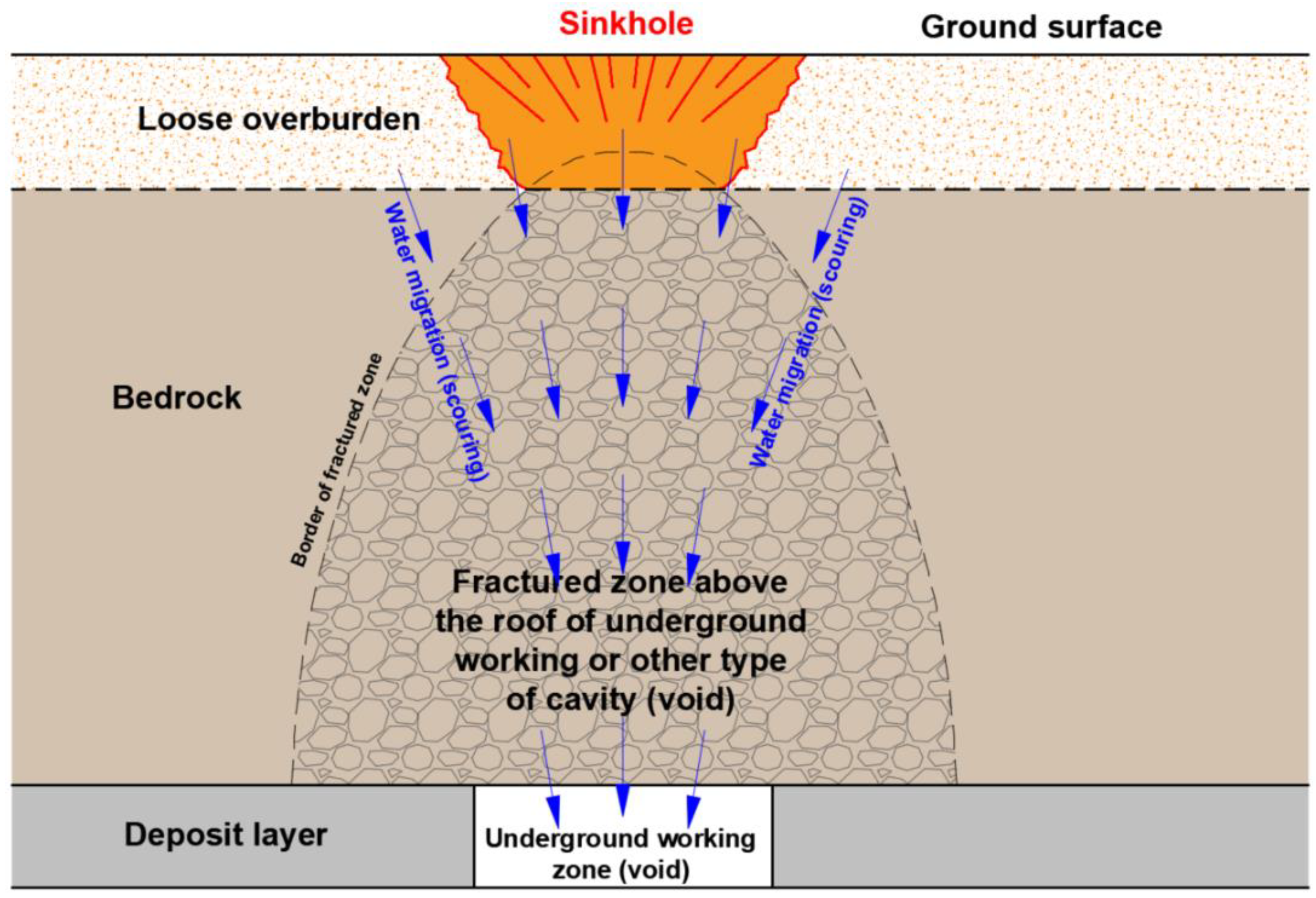
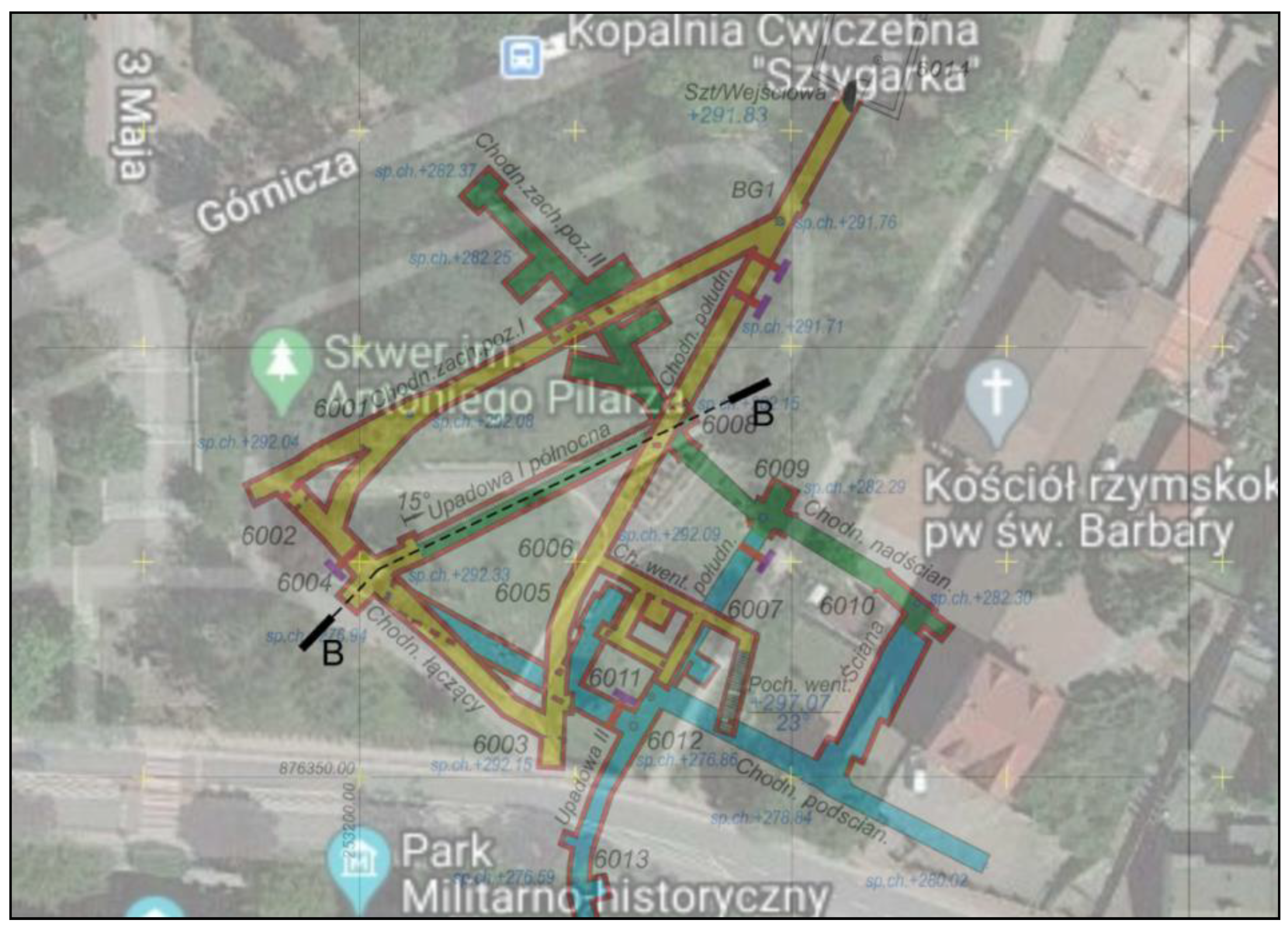


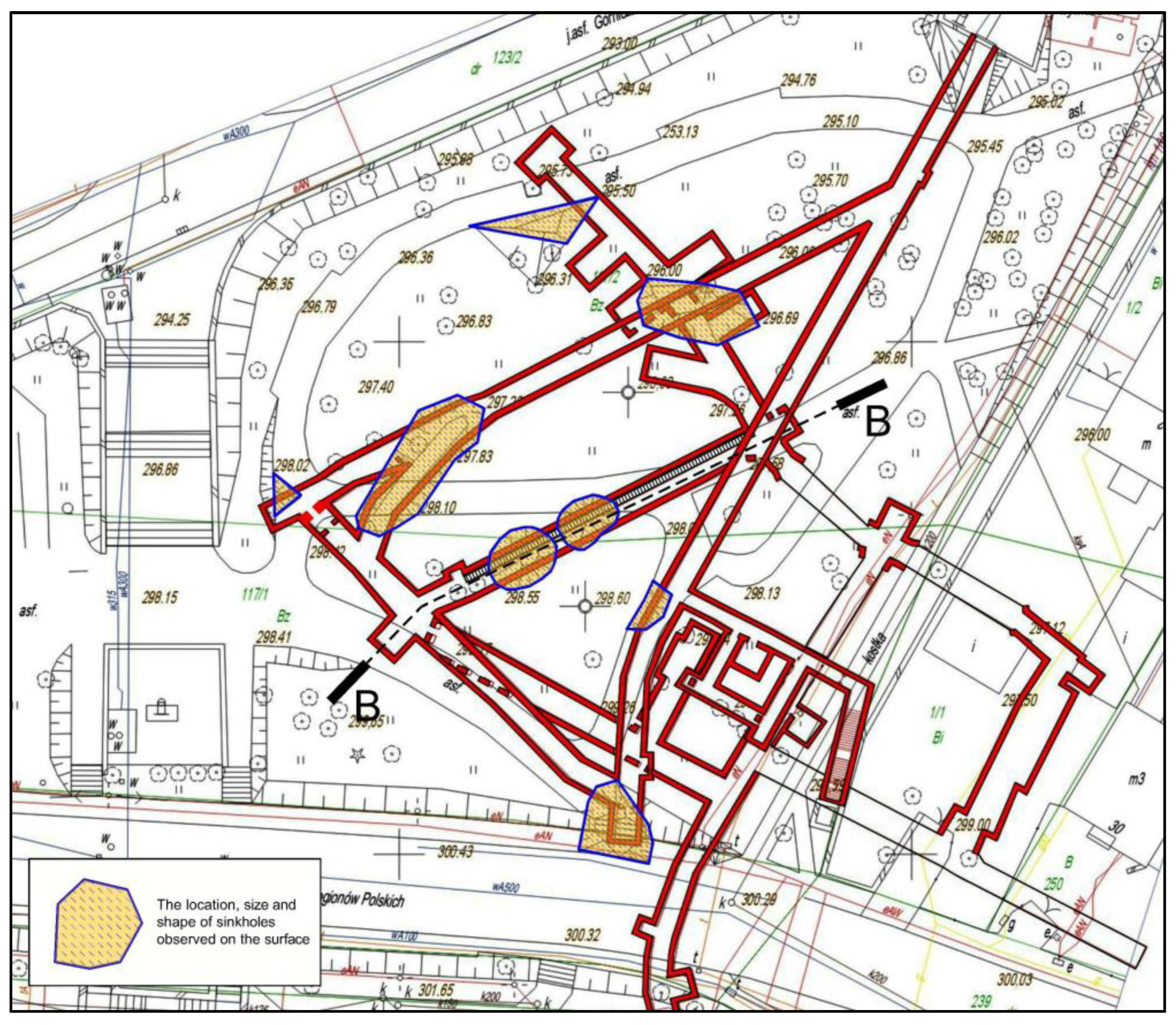
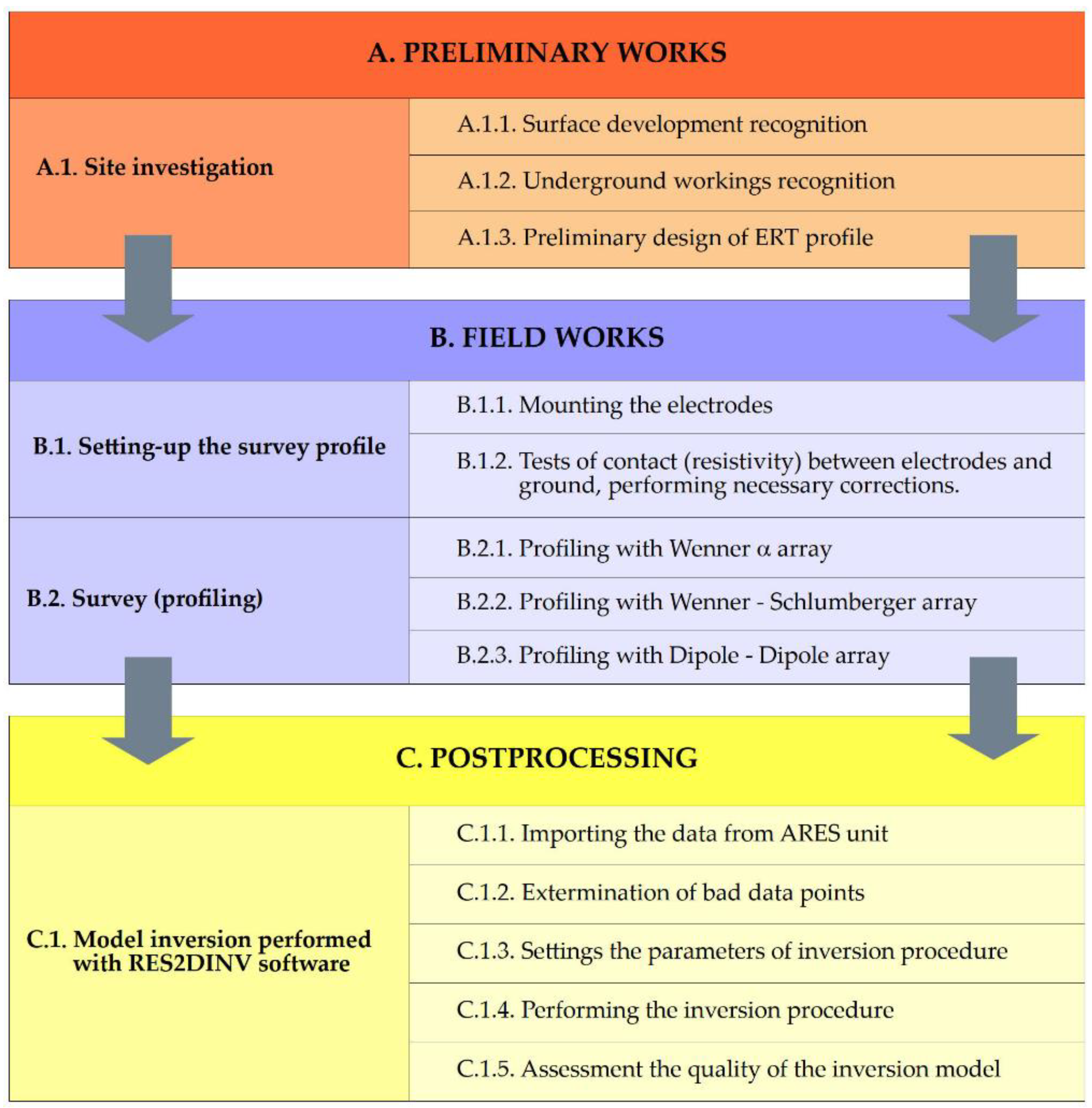
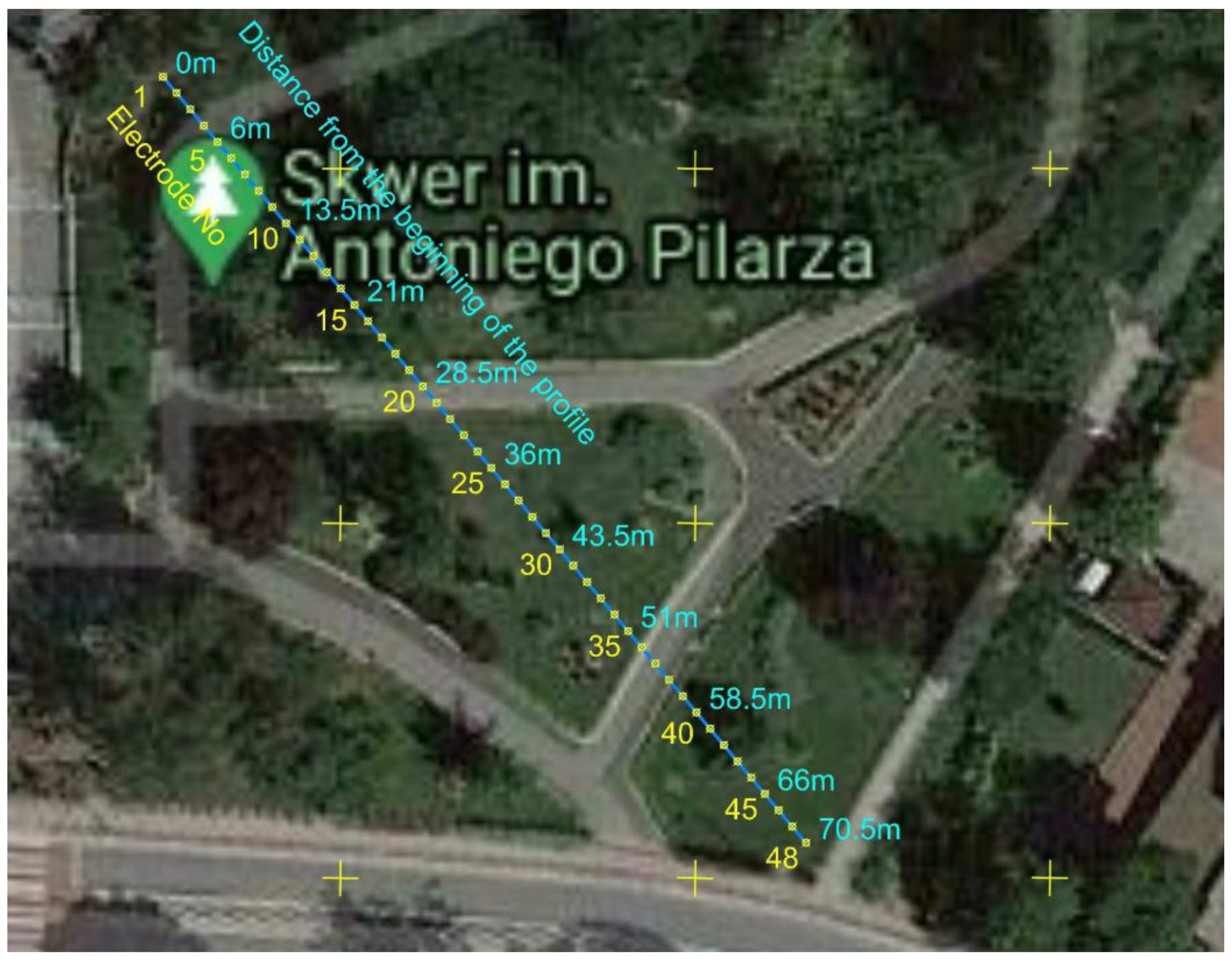
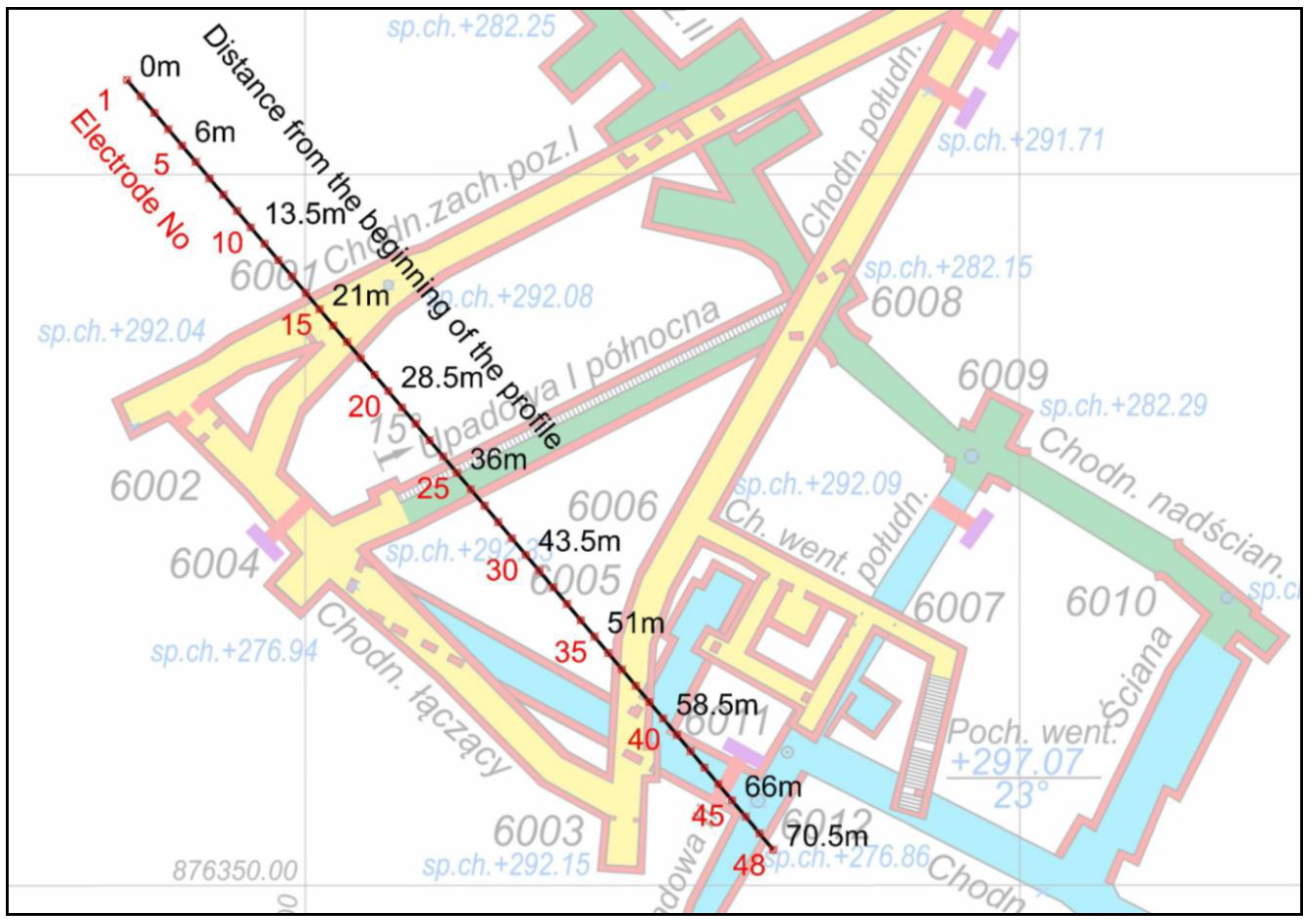
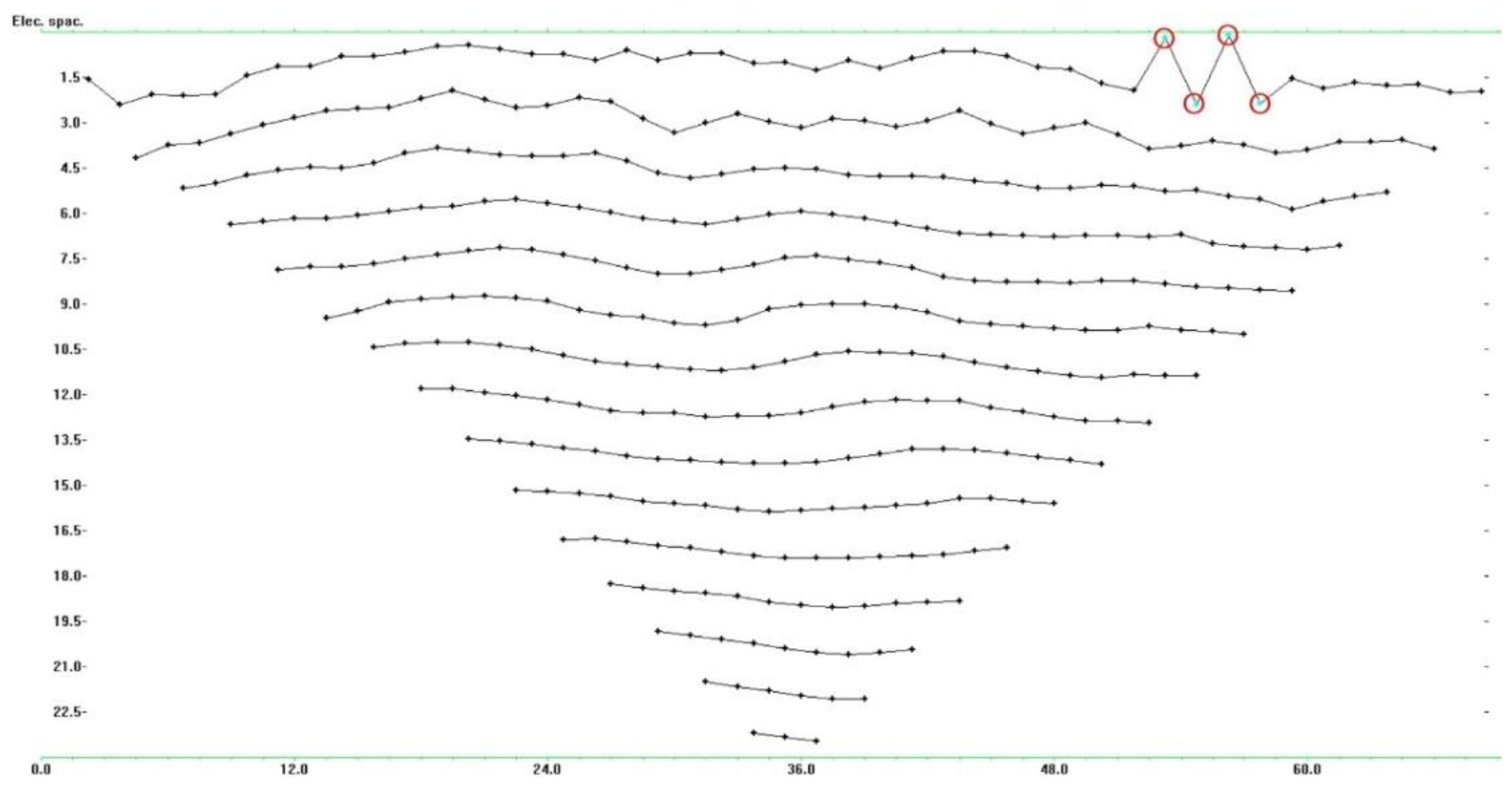

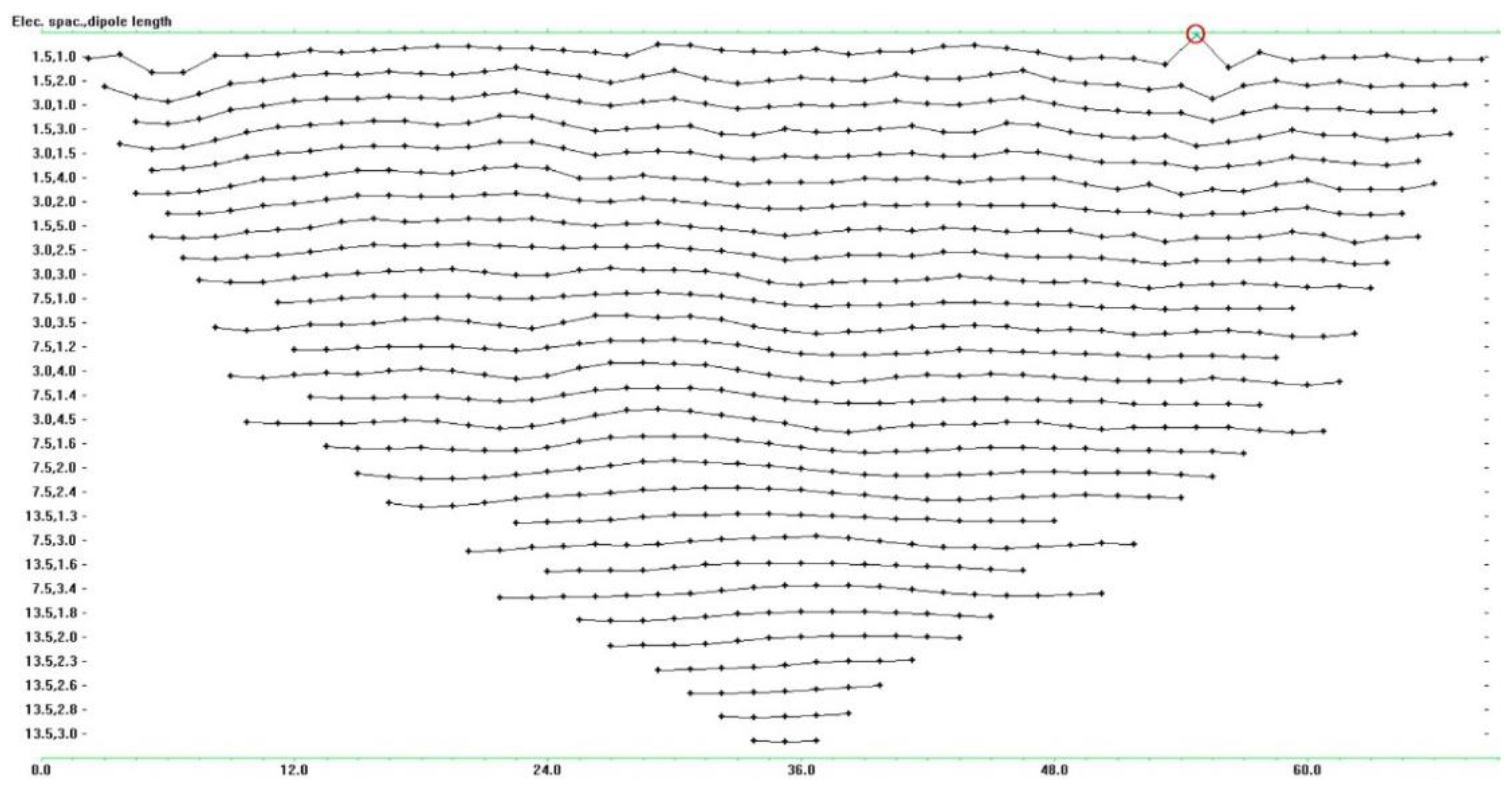




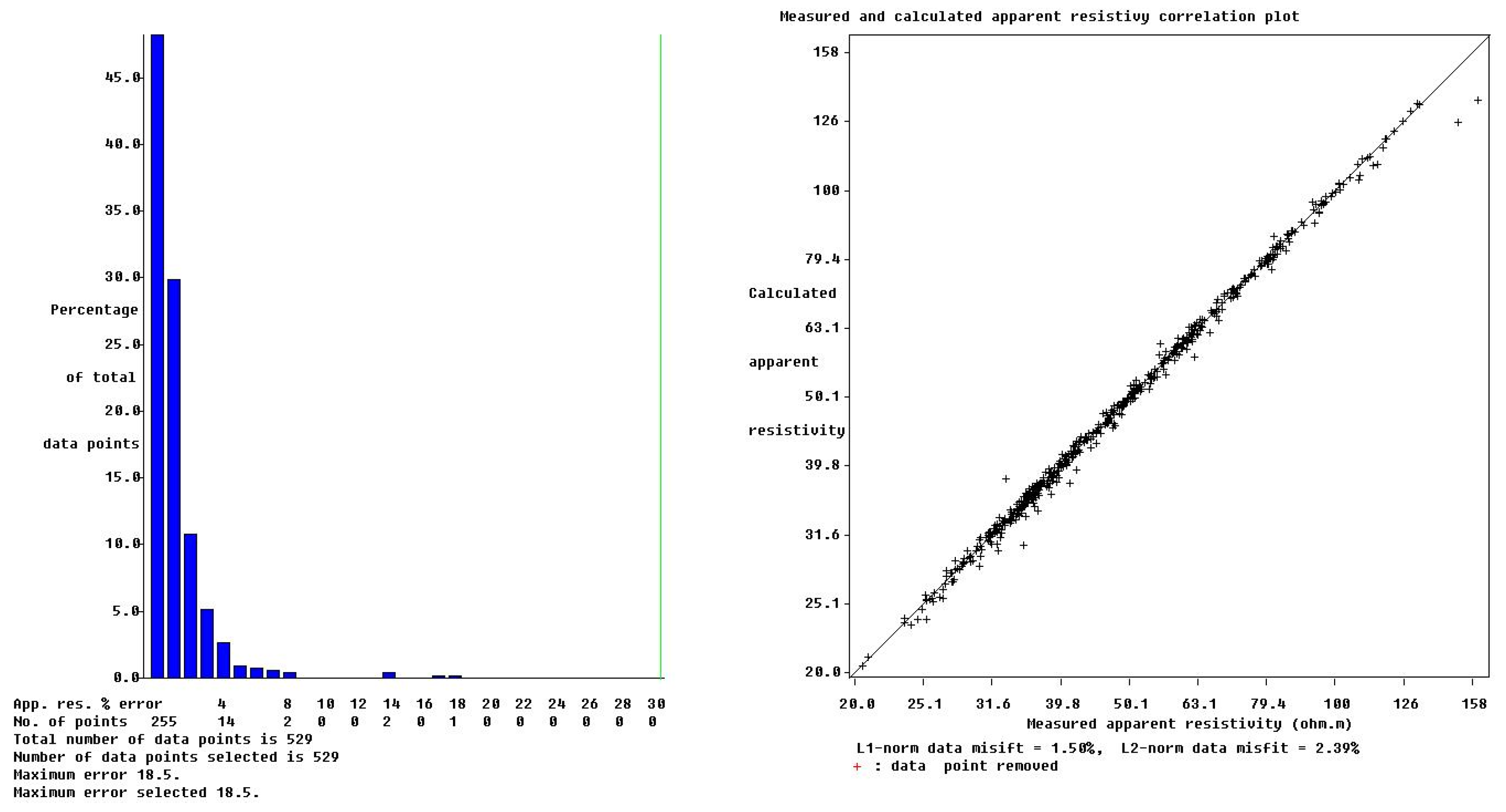
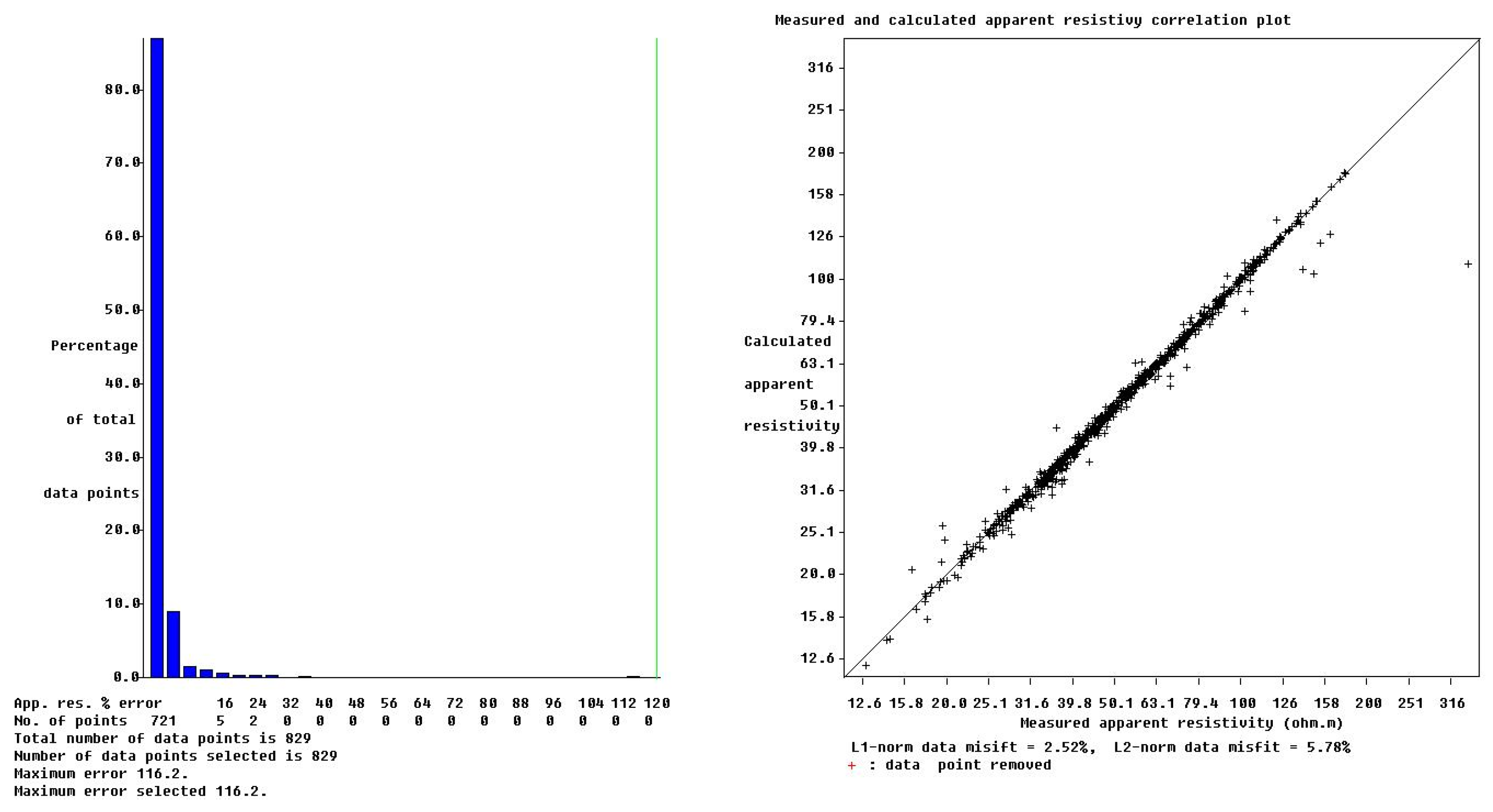
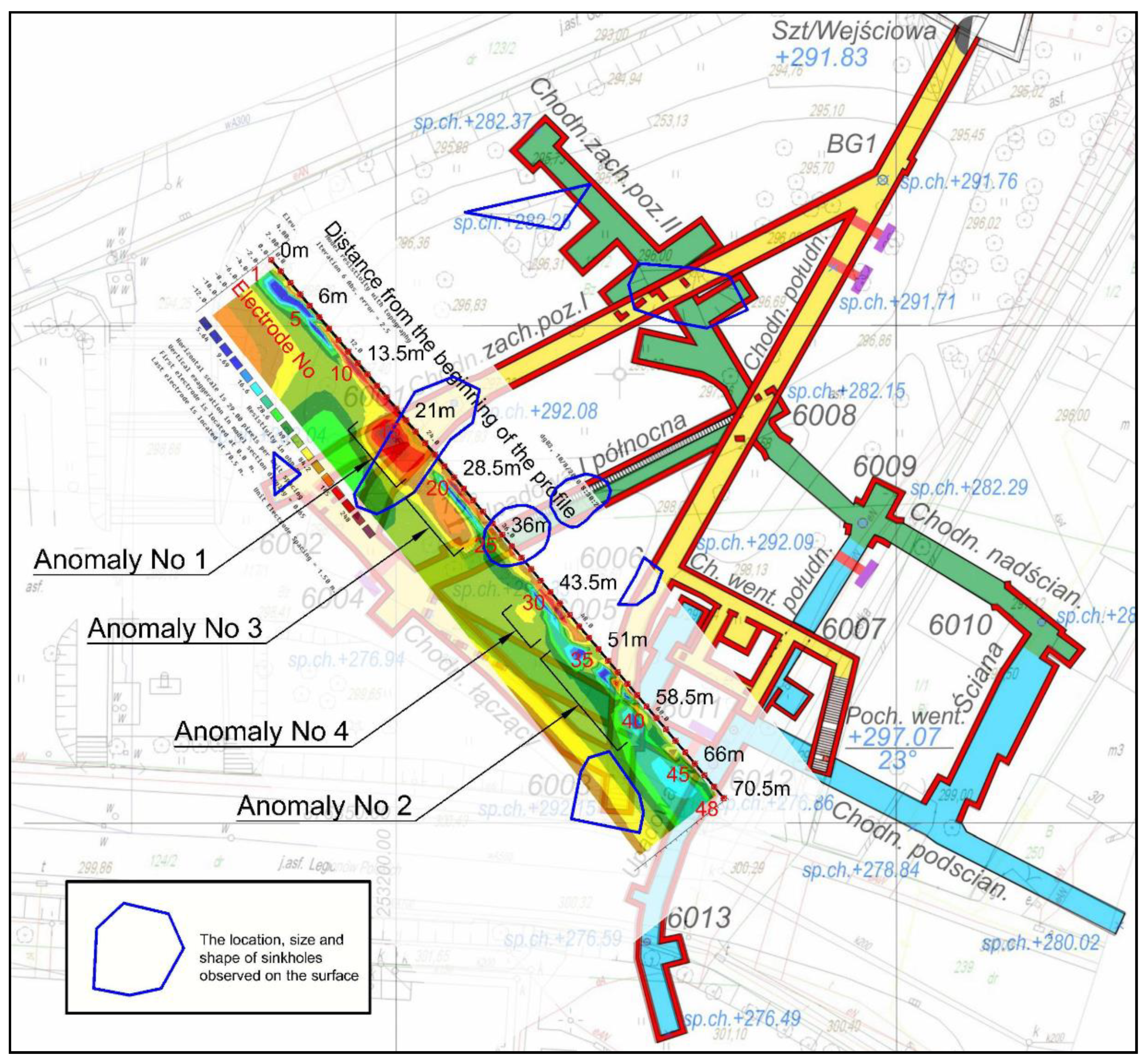
Publisher’s Note: MDPI stays neutral with regard to jurisdictional claims in published maps and institutional affiliations. |
© 2021 by the authors. Licensee MDPI, Basel, Switzerland. This article is an open access article distributed under the terms and conditions of the Creative Commons Attribution (CC BY) license (https://creativecommons.org/licenses/by/4.0/).
Share and Cite
Ścigała, R.; Duży, S.; Szafulera, K.; Kruczkowski, M.; Dyduch, G.; Jendryś, M. Assessment of Sinkhole Hazard in the Area of Shallow Mining Workings Using Electrical Resistivity Tomography. Energies 2021, 14, 8197. https://doi.org/10.3390/en14248197
Ścigała R, Duży S, Szafulera K, Kruczkowski M, Dyduch G, Jendryś M. Assessment of Sinkhole Hazard in the Area of Shallow Mining Workings Using Electrical Resistivity Tomography. Energies. 2021; 14(24):8197. https://doi.org/10.3390/en14248197
Chicago/Turabian StyleŚcigała, Roman, Stanisław Duży, Katarzyna Szafulera, Marek Kruczkowski, Grzegorz Dyduch, and Marek Jendryś. 2021. "Assessment of Sinkhole Hazard in the Area of Shallow Mining Workings Using Electrical Resistivity Tomography" Energies 14, no. 24: 8197. https://doi.org/10.3390/en14248197






